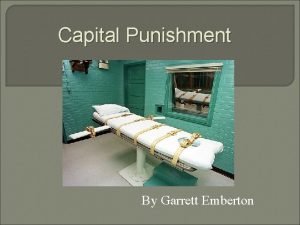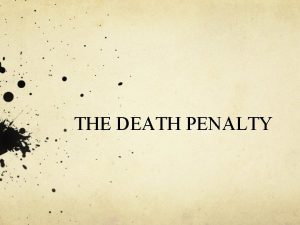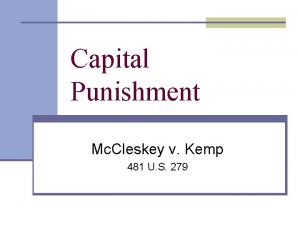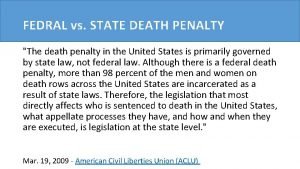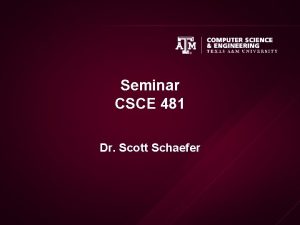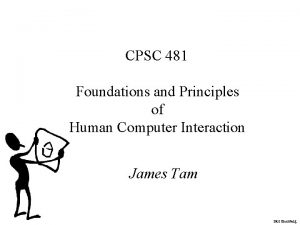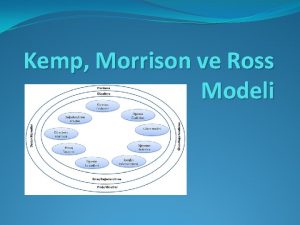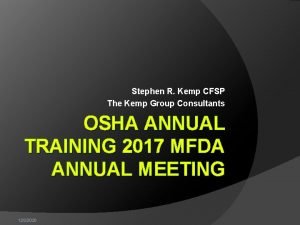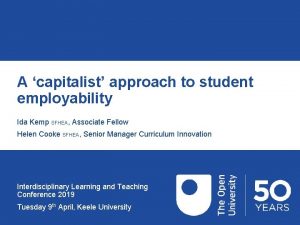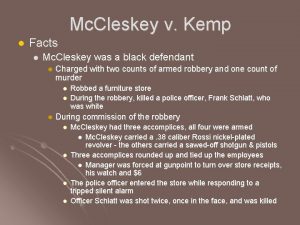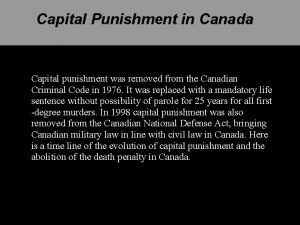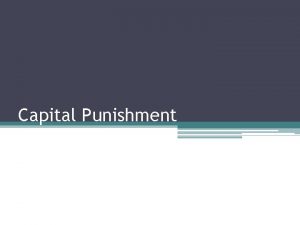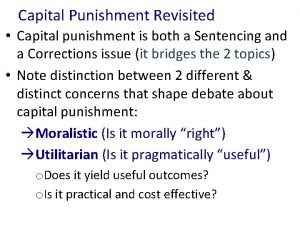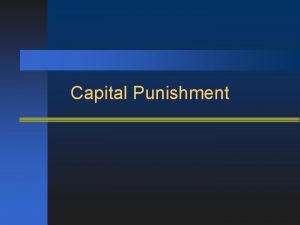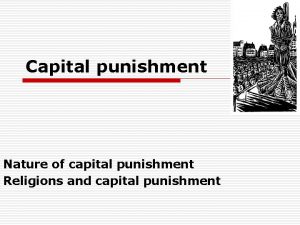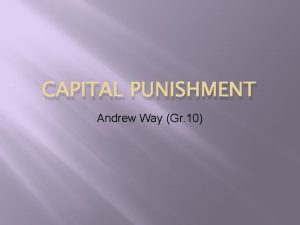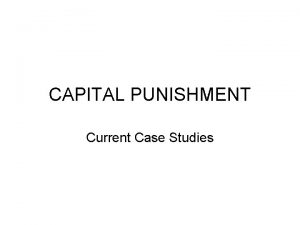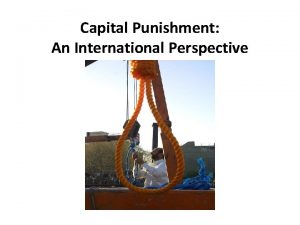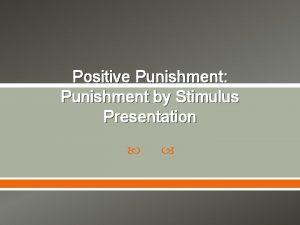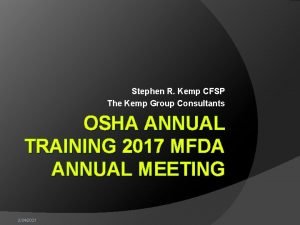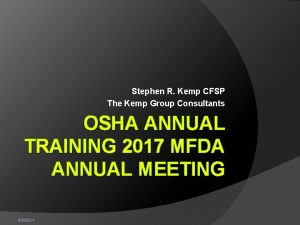Capital Punishment Mc Cleskey v Kemp 481 U




















- Slides: 20

Capital Punishment Mc. Cleskey v. Kemp 481 U. S. 279

Facts n During a store robbery, Mc. Cleskey, a black man, shot and killed a white police officer. n Mc. Cleskey was convicted in the Superior Court of Fulton County, Georgia of two counts of armed robbery and one count of murder. n At the penalty hearing, Mc. Cleskey didn’t present any mitigating circumstances and the jury considered the two aggravated circumstances (victim killed during robbery, victim killed was an on duty police officer) and recommended the death penalty for the murder charge and two consecutive life in prison sentences for robbery.

Procedural History n The trial court followed the jury’s recommendation and sentenced Mc. Cleskey to death, the Supreme Court of Georgia affirmed. n Mc. Cleskey unsuccessfully sought post conviction relief in the state courts. n Then filed for habeas corpus relief in the Federal Court.

Mc. Cleskey’s Claim n He claimed that the death penalty process in Georgia is administered in a racially discriminatory manner in violation of both the 14 th and the 8 th Amendments. n His evidence was a study conducted by David Baldus n This study purports to show a disparity in the imposition of the death sentence in the state of Georgia based on the murder victim’s race and to a lesser extent the defendant’s race.

Federal Court Procedural History n The District Court thought the study was not trustworthy by a ponderous of the evidence and denied his claim. n The Court of Appeals assumed the validity of the study but found it insufficient to demonstrate unconstitutional discrimination on the 14 th Amendment claim or irrational, arbitrary or capricious under the 8 th Amendment claims. n The Supreme Court affirmed the decision of the Court of Appeals in a 5 to 4 decision.

The Baldus Study n The study looked at the 2484 murders and non-negligent manslaughters that took place in Georgia from 1973 -1979. n Of those murders 1665 of the defendants were black and 819 of the defendants were white. n 61% of the victims were black and 39% of the victims were white. n Of the 128 cases which the death penalty was imposed, 108 of the victims were white.

Baldus Study- Raw Numbers n When the defendant is charged with killing a white victim the death penalty is given in 11% of the cases. n When the defendant is charged with killing a black victim, the death penalty is given in 1% of the cases. n There is reverse racial disparity in the race of the defendant (only in raw numbers). n n If black defendant, have a 4% chance of getting the death penalty. If white defendant, have a 7% chance of getting the death penalty.

Baldus Study- Raw Numbers Cont. n The probability of the defendant getting the death penalty. White Victim Black Defend ant 22% 1% White Defend ant 8% 3%

Baldus Study- Raw Numbers n The probability that prosecutor sought the death penalty after murder conviction. White Victim Black Defendant 70% 15% White Defendant 32% 19%

The Baldus Study- Method n The study used a multiple regression analysis to look at the independent impact of racial factors while controlling for 230 variables.

Baldus Study- effects after accounting for non-racial variables n After accounting for 39 non-racial variables (the most legitimate reasons for sentencing distinctions) it is still 4. 3 times more likely that if the victim is white, the defendant will get the death penalty. n This is extraordinary considering that being the prime mover in a homicide only increases the likelihood 2. 3 times and having a prior murder conviction increases the likelihood 4. 9 times.

Baldus study- aggravation levels n At comparable aggravation levels, the death penalty will be imposed in 11% of white victim cases and 5% of black victim cases. This means that over half (55%) of the defendants in white victim crimes would not have been sentenced to death if their victims had been black. n The study found that the racial impact was greatest in the midrange of aggravation level. n As there was less room for discretion in very aggravated cases or only mildly aggravated cases.

Baldus Study- Mc. Cleskey’s case n Mc. Cleskey’s level of aggravation was in this midrange. 34/100 white victim cases get death penalty n 14/100 black victim cases get death penalty n

Weaknesses of Study n The District Court said: n Incomplete data n Unknown variables n Methodology (1) (2) (3) (4) Assumed all information was available at the time of the trial to jury and prosecutors Instability of various models High correlation between race and non-racial factors Inability to predict outcome in actual cases.

Supreme Court Decision n The Supreme Court decision assumed the validity of the Baldus study. n But still found it statistically insufficient to demonstrate the 14 th or 8 th amendment claims.

Majority Opinion- 14 th Amendment Claim n To prevail in an Equal Protection claim he has to prove (1) the existence of purposeful discrimination and (2) that it had a discriminatory effect on him. Can’t ask jury their reasoning. n Discriminatory application is OK as long as it was not enacted or maintained because of an anticipated racially discriminatory effect. n The study doesn’t prove anything about his specific case and he doesn’t offer case specific evidence. n Not like jury venire or Title 7 of Civil Rights that can use risk. n

Majority Opinion- 8 th Amendment Claim n This case is in the constitutionally permissible range of death penalty cases. n n His case doesn’t differ from other cases where defendant got the death penalty and it is not disproportionate to the crime. The court already looked at statute in Gregg and upheld it. n There are safeguards. n He can’t show the system is arbitrary or capricious. n n Discretion is not arbitrary and is necessary. Statistics don’t prove that it is arbitrary in application or that race was a factor in this case. n At most the study shows that discrepancy in sentencing correlates with race but this does not constitute a major systematic defect. n n All systems have weaknesses and flaws, but safeguards make them as fair as possible. This study doesn’t show an unacceptable risk of racial prejudice.

4 main reasons majority ignores study 1) The desire to encourage sentencing discretion 2) The existence of statutory safeguards 1) Could eliminate death penalty if these are not enough. 3) The fear of widespread challenges to other sentencing decisions 1) Attractiveness, hair color 4) Limits of the judicial role 1) This is a legislative question

Dissent on 4 main reasons 1) Need guided discretion, not no discretion 1) Prosecutor guidelines, lists to help juries 2) This is an empirical challenge not a theoretical one 1) Hard evidence that the safeguards aren’t working 3) Fear of opening the floodgates is unfounded 4) The court is the right place to address this 1) Majority can’t dictate conditions of social life and no one else will hear them. Court protects minority.

Four Years Later n Mc. Cleskey was executed on September 25 th, 1991. n In the summer of 1991 Justice Powell, who wrote the majority opinion, made a statement that he thought the death penalty should be abolished.
 Humanist beliefs
Humanist beliefs Capital punishment definition
Capital punishment definition Capital punishment thesis statement
Capital punishment thesis statement Capital punishment definition
Capital punishment definition Capital punishment mc
Capital punishment mc Fedral
Fedral Prototype reddit
Prototype reddit Liedboek 479
Liedboek 479 Csce 481
Csce 481 Scott schaefer tamu
Scott schaefer tamu Cpsc 481
Cpsc 481 Morrison ross and kemp model
Morrison ross and kemp model Kemp's instructional design model
Kemp's instructional design model Lizzie coles-kemp
Lizzie coles-kemp Jerrold kemp
Jerrold kemp Brendan kemp
Brendan kemp Kemp kernstine md mesothelioma
Kemp kernstine md mesothelioma The kemp group
The kemp group Library and book mould removal
Library and book mould removal Ida kemp
Ida kemp ægtefællebegunstigende kombinationssæreje
ægtefællebegunstigende kombinationssæreje


